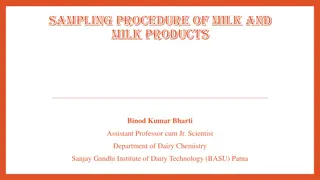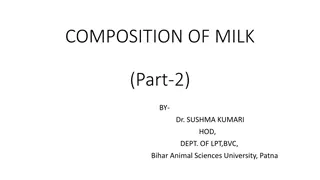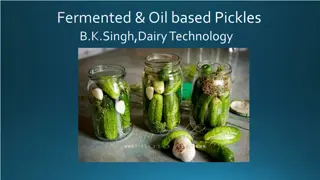Understanding the Role of Starter Culture in Fermented Milk Products
Starter cultures play a crucial role in the production of fermented milk products by producing antimicrobial compounds like organic acids, H2O2, CO2, aroma compounds, fatty acids, and bacteriocins. These compounds help prevent spoilage by inhibiting the growth of harmful bacteria and altering cellular processes. The production of lactic acid, acetic acid, propionic acid, and other compounds contributes to the unique flavors and textures of these products. Understanding the mechanisms behind these antimicrobial compounds is essential for improving the quality and safety of fermented milk products.
Download Presentation

Please find below an Image/Link to download the presentation.
The content on the website is provided AS IS for your information and personal use only. It may not be sold, licensed, or shared on other websites without obtaining consent from the author. Download presentation by click this link. If you encounter any issues during the download, it is possible that the publisher has removed the file from their server.
E N D
Presentation Transcript
Starter Culture and Fermented Milk Products DR. Sonia Kumari Asstt .Prof Cum Jr. Scientist Dairy Microbiology SGIDT, BASU Patna-800014
Antimicrobial Compounds Produced by Starters culture Organic acids : Lactic acid, acetic acid, prop ionic acid etc. Hydrogen ion concentration (pH) Low oxidation reduction potential H2O2and CO2 Aroma compounds diacetyl, acetaldehyde Fatty acids Bacteriocins etc
Organic acids : Lactic acid. It is un dissociated at low pH therefore highly toxic to many microorganisms. Acetic acid and propionic acid have more antimicrobial activity than lactic acid due to its higher pKa values. The antimicrobial effect of organic acid lies in the reduction of pH as well as the undissociated forms of molecules. The low external pH causes acidification of cell cytoplasm, while the undissociated form of molecule may cause alternation in the cell membrane permeability, collapsing the electrochemical proton gradient that results in disruption of substrate transfer system.
H2O2and CO2: Some lactobacilli are known to produce H2O2form glycerol, under aerobic conditions. The antimicrobial activity of H2O2results from the oxidation of SH groups causing denaturation of a number of enzymes and from the peroxidation of membrane lipids that increased membrane permeability. H2O2also acts as a precursor for the production of bactericidal free radicals such as superoxide O2, and hydroxides OH radicle that can damage DNA. Lactobacillus and Lactococcus species can produce H2O2 while CO2 is mainly produced by heterofermentative LAB. It is believed that it may play a role in creating an anerobic environment which inhibits enzymatic decarboxylation reactions and the accumulation of CO2in the lipid bilayer of cell membrane that may disrupt permeability.
Aroma compounds and fatty acid Diacetyl : LAB inhibits the growth of Gram negative bacteria by reacting with the arginine (Arg) binding protein, thus affecting Arg utilization finally interfere with protein synthesis. Acetaldehyde is converted to H2O2 in the presence of xanthine oxidase or glucose oxidase activites. Some Lactobacillus and Lactococci possess lipolytic activity may produce significant amount of fatty acids. The unsaturated fatty acids are active against many Gram +ve bacteria.
Bacteriocins S.N. Species Compound 1. Lactococcus lactis subsp lactis Nisin 2 Lactococcus lactis subsp Diplococcin cremoris. 3 Lb. acidophilus Acidolin 4. Lb. helveticus. Lactacin 27
Nisin It has a narrow spectrum anti-bacterial activity and does not inhibit Gram ve bacteria, yeast, or fungi. It inhibits closely relative organisms like Lactococcus lactis subsp cremoris. It is effective against spore formers. Its synthesis occurs as pronisin in the cell and it further converted to Nisin in the outer layer of the cell.
TYPES OF INTERACTION AMONG STARTER CULTURES Neutralism : Two organisms living in a close proximity but not affected by each other since growth requirement are quite different so between them for nutrients. no competition Antagonism : One organism adversely affects the environment of another organism .Antibiosis is the production of antibiotic or inhibitory substances by one organism on another partner. eg Lactic acid bacteria produce lactic acid that is inhibitory to other spoilage organisms. Symbiosis: Symbiosis is the relationship between two (or more) organisms that live in a close association. In majority of symbioses one or both partners gain something positive form the association. Although the pair of symbionts may be able to live separately, but they always do better in the long run by living together.
Interaction among Microorganisms Mutualism Form of positive interaction in which each partner get benefits from the association but the manner in which benefited varies. There may be exchange of nutrition between two species i.e is known as Syntrophism. Association results in desired end products which is not possible by the organism separately. Commensalisms: association but the other organism in turn is not affected. Host organism by its growth affects the physical or physiological environment in such a way that favors the growth of dependent partner.eg. eg Facultative organism grows and produces anaerobic conditions that favour growth of anerobs. Growth of yeasts in sugar solutions reduces the concentration of sugar thus permitting growth of bacteria. Relationship which only partner get benefited from the Synergism: The ability of two or more organisms to bring about an effect greater than the sum of their individual effects. The changes are usually chemical in nature that cannot be accomplished alone. eg : Association of two microorganism in the yoghurt starter culture, mixed yoghurt cultures of S. thermophilus and Lactobacillus delbrueckii subsp bulgaricus bacteria were used as compared with the single strains.























